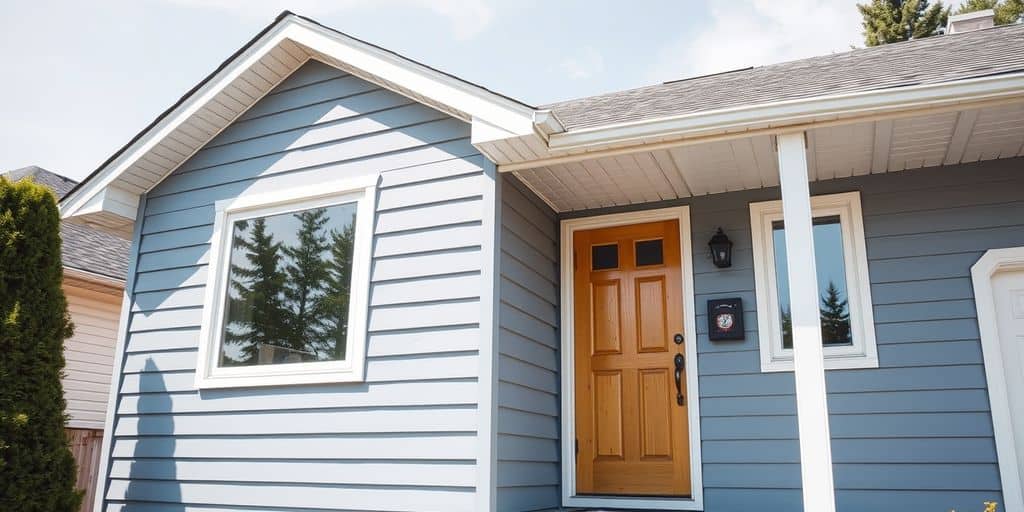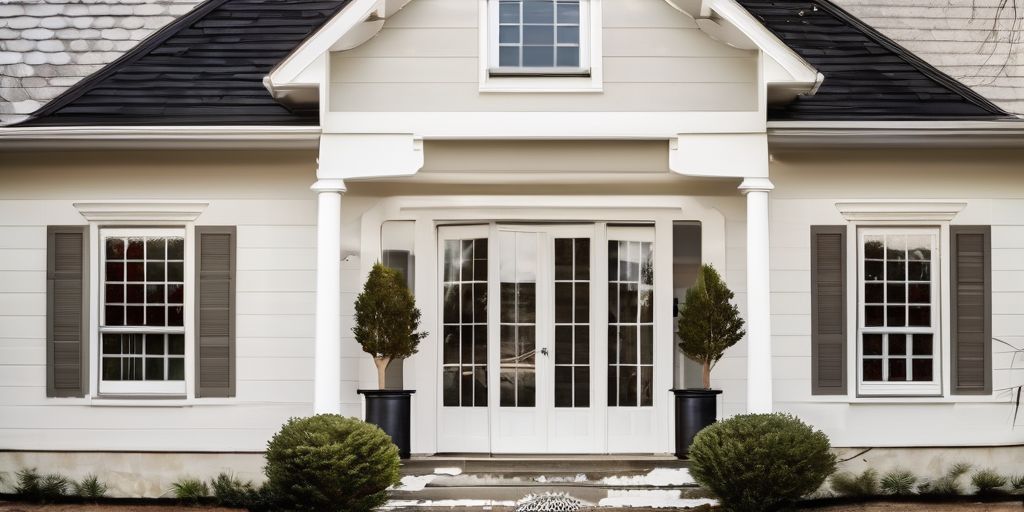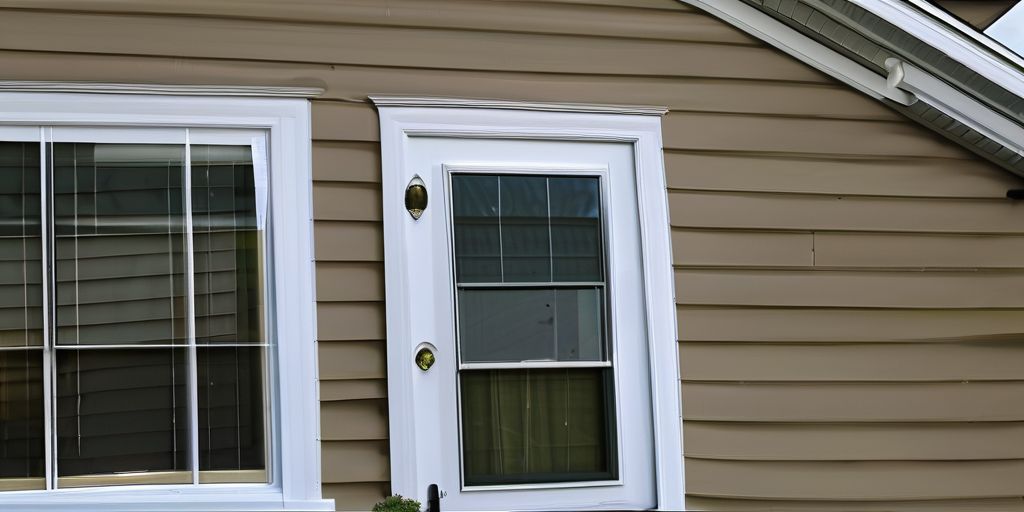Painting your vinyl siding in a blue grey shade can give your home in Guelph a fresh and modern look. This guide will walk you through everything you need to know, from choosing the perfect shade to maintaining your newly painted siding. Whether you’re a DIY enthusiast or considering professional help, these steps will ensure a smooth and successful project.
Key Takeaways
- Selecting the right shade of blue grey is essential for a great look and long-lasting results.
- Proper preparation, including cleaning and priming, is crucial for the paint to adhere well.
- Using the right tools and materials will make the job easier and more efficient.
- Following a step-by-step guide will help you achieve a professional finish.
- Regular maintenance will keep your newly painted siding looking fresh for years.
Choosing the Perfect Shade of Blue Grey
Factors to Consider
When picking the ideal shade of blue grey for your vinyl siding, several factors come into play:
- Climate: In Guelph, the weather can be quite varied. Choose a shade that can withstand both sunny summers and cold winters.
- Lighting: The same color can look different depending on the time of day and the amount of sunlight your home gets.
- Home Style: Traditional homes might look better with softer shades, while modern homes can handle bolder hues.
- Surroundings: Think about the colors in your yard and neighborhood. A shade that complements your garden or nearby landmarks can be a great choice.
Popular Blue Grey Options
Here are some popular blue grey shades to consider:
- Skyline Steel: A soft, muted blue with grey undertones, perfect for a serene and inviting look.
- Coastal Fog: A blend of blue and grey that captures the essence of a misty shoreline.
- Stormy Monday: A deeper, more dramatic hue that can make a bold statement.
- Whispering Rain: A light and airy blue grey that reflects the sky on a tranquil day.
While all these shades are versatile, it’s important to consider the lighting and architectural style of your home, as well as the surrounding landscape.
Tips for Selecting the Perfect Shade
Choosing the right shade of blue grey can be tricky. Here are some tips to help you out:
- Test Small Areas: Paint small sections of your siding to see how the color looks at different times of the day.
- Think Long-Term: Choose a shade that you will be happy with for years to come.
- Consult a Color Wheel: This can help you see which shades of blue grey will complement other colors on your home.
- Ask for Opinions: Sometimes a second opinion can help you make the final decision.
Remember, the goal is to choose a color that not only appeals to you but also adds to the overall beauty and value of your home.
Preparing Your Vinyl Siding for Painting
Cleaning and Priming
Before applying a fresh coat of paint to your vinyl siding, it’s crucial to ensure the surface is clean and primed. Dirt, mildew, and chalky residue can prevent paint from adhering properly, leading to a less durable finish. Here’s how to prepare your siding:
- Start by washing the walls with a solution of water and a mild cleaner. For more stubborn grime, a mixture containing trisodium phosphate (TSP) can be effective.
- Rinse the siding thoroughly with clean water to remove any cleaning residue.
- Inspect the siding for any signs of rust or damage. If present, apply a weather- and corrosion-resistant primer to these areas.
- Allow the primer to dry completely before proceeding with painting. This step is essential for a smooth and even application of paint.
Remember, patience during the priming process ensures a professional-looking finish that lasts.
By following these steps, you’ll create a clean and receptive surface for your new coat of blue grey paint, enhancing the curb appeal of your home.
Repairing Damaged Areas
Before you can begin to transform your home’s exterior with a fresh coat of blue grey, it’s crucial to address any damaged areas on your vinyl siding. This step is essential to ensure a smooth and even application of paint, and to prevent future complications.
- Inspect your siding thoroughly for any signs of damage such as cracks, holes, or warping.
- Remove any damaged pieces by working your hand into a seam between pieces and releasing the siding from the nailing strip. Carefully pull the nails holding the damaged siding to remove it.
- Measure and cut a new piece of vinyl siding to fit the gap left by the removed piece, ensuring a snug fit.
- Secure the new siding in place by nailing it to the nailing strip, taking care not to drive the nails in too tightly as vinyl needs room to expand and contract with temperature changes.
Preparation is key to a successful paint job. After repairing, it’s important to smooth out any rough edges and ensure the surface is clean and ready for priming. A meticulous repair job will greatly enhance the final appearance and durability of your painted siding.
Protecting Surrounding Surfaces
Before you begin the transformation of your vinyl siding with a fresh coat of blue grey, it’s crucial to protect the areas around your work zone. Careful preparation ensures a clean and professional finish, free from accidental paint splatters or spills.
- Use drop cloths or plastic sheeting to cover landscaping and nearby structures.
- Mask off windows, doors, and trim with painter’s tape to create sharp paint lines.
- Remove or cover light fixtures and other non-paintable items to avoid damage.
Remember, the time spent on safeguarding your property will pay off in the ease of cleanup and the quality of your painting job.
In Guelph, where the weather can be unpredictable, it’s especially important to check the forecast and prepare for potential wind that could disrupt your protective setup. If you’re painting near iconic landmarks like the University of Guelph, extra care should be taken to maintain the pristine environment.
Essential Tools and Materials for Painting Vinyl Siding
Must-Have Painting Tools
When painting vinyl siding, having the right tools is crucial for a successful outcome. Here’s a list of essential painting tools you’ll need:
- Paint rollers and extension poles for reaching higher areas
- A variety of paintbrushes for detailed work and edges
- Drop cloths or plastic sheeting to protect the ground and nearby plants
- Painter’s tape for clean edges and protecting windows and trim
- Sanding sponges to smooth out any rough surfaces
- A paint tray or a 5-gallon bucket with a grid
Remember, the quality of your tools can greatly influence the finish of your paint job. Investing in good-quality brushes and rollers can save you time and effort in the long run.
Recommended Paint Types
Selecting the right paint and primer is crucial for a successful vinyl siding paint job. High-quality paint is not only about the color but also its ability to withstand the elements and adhere to the vinyl surface. Here are some key considerations:
- Durability: The paint should resist fading, cracking, and peeling. Look for products specifically designed for exterior use on vinyl.
- Flexibility: Given the expansion and contraction of vinyl siding with temperature changes, the paint must be flexible enough to move with the material.
- Adhesion: A good primer can greatly improve the adhesion of paint to vinyl, ensuring a longer-lasting finish.
When painting in areas like Guelph, where humidity can be a factor, it’s important to choose paint that is suitable for humid conditions.
Safety Gear and Equipment
When painting vinyl siding, it is crucial to prioritize your safety. Proper safety gear is essential to protect yourself from potential hazards associated with painting.
- Safety Glasses: Protect your eyes from paint splatters and debris.
- Gloves: Choose durable gloves to shield your hands from chemicals and abrasions.
- Respirator or Mask: Essential for filtering out paint fumes and particulates.
- Protective Clothing: Wear long sleeves and pants to cover your skin.
- Shoes with Good Traction: Prevent slips and falls, especially if you’re working on a ladder.
Remember, investing in quality safety gear not only ensures your well-being but also contributes to a more professional painting outcome.
Step-by-Step Guide to Painting Vinyl Siding
Painting your vinyl siding can be a rewarding project if done correctly. Follow this step-by-step guide to ensure a professional finish.
Setting Up Your Work Area
- Choose a dry day: Weather conditions play a crucial role. Avoid painting on rainy or overly humid days.
- Clear the area: Remove any obstacles around your work zone.
- Protect surroundings: Use drop cloths or plastic sheeting to cover plants, walkways, and other surfaces.
- Gather your tools: Ensure you have all necessary tools and materials within reach.
Applying the Paint
- Start from the top: Begin painting at the top of the siding and work your way down to prevent drips.
- Use thin coats: Apply the paint in thin, even layers to avoid bubbling or peeling.
- Allow drying time: Let the first coat dry completely before applying a second coat if needed.
- Check for missed spots: Inspect your work and touch up any areas that need more coverage.
Finishing Touches and Cleanup
- Remove protective coverings: Carefully take off any painter’s tape and drop cloths.
- Clean your tools: Wash brushes and rollers thoroughly for future use.
- Inspect the paint job: Look for any final touch-ups that might be needed.
- Dispose of waste properly: Ensure all paint cans and materials are disposed of according to local regulations.
Remember, taking your time with each step will result in a more durable and visually appealing finish.
By following these steps, you’ll achieve a beautiful, long-lasting paint job on your vinyl siding.
Maintaining Your Newly Painted Vinyl Siding
Regular Cleaning Tips
Keeping your vinyl siding clean is essential for maintaining its fresh look. Here are some tips:
- Inspect regularly: Check your siding for dirt, grime, or mildew.
- Gentle cleaning: Use a garden hose to wash away dust and debris.
- Mild detergent: For tougher spots, mix water with a mild detergent and scrub gently.
- Rinse thoroughly: Ensure all soap is rinsed off to prevent residue.
Regular cleaning helps in preserving the appearance and longevity of your paint.
Touch-Up Techniques
Over time, you might notice small areas where the paint has chipped or faded. Here’s how to handle touch-ups:
- Clean the area: Remove any dirt or loose paint.
- Sand lightly: Smooth out the edges around the chipped area.
- Apply primer: Use a small brush to apply primer to the exposed vinyl.
- Paint: Once the primer is dry, apply the matching paint color.
Protecting Against Weather Damage
Weather can take a toll on your painted siding, especially in areas with variable conditions like Guelph. Here’s how to protect it:
- Sealant application: Apply a clear sealant to add an extra layer of protection.
- Check for damage: Regularly inspect for cracks or peeling and address them promptly.
- Avoid harsh conditions: Try to avoid exposing your siding to extreme weather right after painting.
Proper maintenance ensures your vinyl siding remains vibrant and durable for years to come.
Common Mistakes to Avoid When Painting Vinyl Siding
Painting vinyl siding can be a rewarding project, but it’s important to avoid common mistakes to ensure a long-lasting, professional finish. Here are some pitfalls to watch out for:
Skipping Surface Preparation
Proper surface preparation is crucial for a successful paint job. Skipping this step can lead to poor paint adhesion and a shorter lifespan for your paint job. Make sure to:
- Clean the siding thoroughly to remove dirt, grime, and mildew.
- Repair any damaged areas before painting.
- Sand rough spots to create a smooth surface.
Using the Wrong Paint
Not all paints are suitable for vinyl siding. Using the wrong type of paint can result in peeling, cracking, and fading. Look for paint that is:
- Specifically designed for exterior use on vinyl.
- Flexible enough to move with the siding as it expands and contracts.
- Durable and resistant to weather conditions.
Ignoring Weather Conditions
Weather plays a significant role in the success of your painting project. Painting in unfavorable conditions can lead to poor results. Avoid painting when:
- The temperature is too high or too low.
- It’s too humid or raining.
- There’s direct sunlight on the siding.
In Guelph, it’s essential to check the weather forecast before starting your project. The local climate can be unpredictable, so plan accordingly to ensure the best results.
By avoiding these common mistakes, you can achieve a beautiful and long-lasting finish for your vinyl siding.
When painting vinyl siding, it’s easy to make mistakes that can ruin the look of your home. Avoid common errors like skipping the cleaning step or using the wrong type of paint. For more tips and professional help, visit our website. We offer expert advice and services to ensure your home looks its best.
Conclusion
Painting your vinyl siding in a blue-grey shade can truly transform your home in Guelph. By following the steps and tips we’ve shared, you can achieve a beautiful and long-lasting finish. Remember, the key to success is in the preparation and using the right materials. Take your time, enjoy the process, and soon enough, your home will have a fresh, new look that stands out in the neighborhood. Happy painting!
Frequently Asked Questions
Can I paint my vinyl siding any color?
Yes, you can paint vinyl siding in various colors, including blue-grey. Just make sure to use paint that’s made for vinyl surfaces.
Do I need to prime my vinyl siding before painting?
Yes, priming your vinyl siding before painting helps the paint stick better and last longer.
How long does it take to paint vinyl siding?
The time it takes can vary. Usually, it takes a few days, depending on the size of the area and weather conditions.
Can I paint over damaged areas on my vinyl siding?
You can paint over small damaged areas, but it’s best to fix any major damage first to get a smooth finish.
Is it necessary to clean the vinyl siding before painting?
Yes, cleaning the vinyl siding before painting is important to remove dirt and grime, helping the paint adhere better.
What kind of paint should I use for vinyl siding?
Use acrylic, urethane, or latex-based paints for the best results on vinyl siding.





